Developing a Tool for Calculating the Carbon Footprint in SMEs
Abstract
:1. Introduction
1.1. Small and Medium Enterprises (SMEs) and Circular Economy (CE)
1.2. Information Technology (IT) and Circular Economy (CE)
- Integration of IoT systems for better supply chain management and data documentation.
- Optimization of the production process.
- Traceability would allow for increased control over the production process and limit errors.
- Data collection, processing, and information visualization would help SMEs utilize relevant information.
2. Materials and Methods
- Map their business processes according to the LCA method
- Calculate the product CF
- Gain a better insight into the carbon impact of their business
- Identify carbon-intensive procedures in their business cycle
2.1. Case Study
2.2. Data Collection
3. Tool’s Description and Results
- The dashboard, which provides an overview of the company’s emissions at the corporate level
- The company, where the user can map the company’s structure by adding different departments (facilities), equipment used in those departments, and company-owned vehicles.
- The QMS (abbreviation for Quality Management System) allows the user to design the production process; create an inventory of materials (raw materials, semi-ready products, and final products), suppliers, customers, and distributors; and manage orders, receipts, and storage of the materials.
- The ENV is where the user can manage any energy-related information, such as adding power sources and their respective emission factors and keeping a record of energy-related bills.
4. Discussion
5. Conclusions
6. Patents
Author Contributions
Funding
Institutional Review Board Statement
Informed Consent Statement
Data Availability Statement
Conflicts of Interest
References
- IPCC. AR6 Synthesis Report: Climate Change 2023; IPCC: Geneva, Switzerland, 2023; Available online: https://www.ipcc.ch/report/sixth-assessment-report-cycle/ (accessed on 10 December 2023).
- Hoegh-Guldberg, O.; Jacob, D.; Taylor, M.; Guillén Bolaños, T.; Bindi, M.; Brown, S.; Camilloni, I.A.; Diedhiou, A.; Djalante, R.; Ebi, K.; et al. The Human Imperative of Stabilizing Global Climate Change at 1.5 °C. Science 2019, 365, eaaw6974. [Google Scholar] [CrossRef] [PubMed]
- Arneth, A.; Shin, Y.-J.; Leadley, P.; Rondinini, C.; Bukvareva, E.; Kolb, M.; Midgley, G.F.; Oberdorff, T.; Palomo, I.; Saito, O. Post-2020 Biodiversity Targets Need to Embrace Climate Change. Proc. Natl. Acad. Sci. USA 2020, 117, 30882–30891. [Google Scholar] [CrossRef] [PubMed]
- European Food Safety Authority (EFSA); Maggiore, A.; Afonso, A.; Barrucci, F.; Sanctis, G.D. Climate Change as a Driver of Emerging Risks for Food and Feed Safety, Plant, Animal Health and Nutritional Quality. EFSA Support. Publ. 2020, 17, 1881E. [Google Scholar] [CrossRef]
- Moriarty, P.; Honnery, D. The Risk of Catastrophic Climate Change: Future Energy Implications. Futures 2021, 128, 102728. [Google Scholar] [CrossRef]
- Meinshausen, M.; Lewis, J.; McGlade, C.; Gütschow, J.; Nicholls, Z.; Burdon, R.; Cozzi, L.; Hackmann, B. Realization of Paris Agreement Pledges May Limit Warming Just below 2 °C. Nature 2022, 604, 304–309. [Google Scholar] [CrossRef] [PubMed]
- Höhne, N.; Gidden, M.J.; den Elzen, M.; Hans, F.; Fyson, C.; Geiges, A.; Jeffery, M.L.; Gonzales-Zuñiga, S.; Mooldijk, S.; Hare, W.; et al. Wave of Net Zero Emission Targets Opens Window to Meeting the Paris Agreement. Nat. Clim. Chang. 2021, 11, 820–822. [Google Scholar] [CrossRef]
- Matthews, H.D.; Wynes, S. Current Global Efforts Are Insufficient to Limit Warming to 1.5 °C. Science 2022, 376, 1404–1409. [Google Scholar] [CrossRef]
- Brundtland, G.H. Our Common Future—Call for Action. Environ. Conserv. 1987, 14, 291–294. [Google Scholar] [CrossRef]
- Hajian, M.; Jangchi Kashani, S. 1—Evolution of the Concept of Sustainability. From Brundtland Report to Sustainable Development Goals. In Sustainable Resource Management; Hussain, C.M., Velasco-Muñoz, J.F., Eds.; Elsevier: Amsterdam, The Netherlands, 2021; pp. 1–24. [Google Scholar] [CrossRef]
- Mondini, G. Sustainability Assessment: From Brundtland Report to Sustainable Development Goals. Valori Valutazioni 2019, 23, 129–137. [Google Scholar]
- Schaltegger, S.; Wagner, M. Sustainable Entrepreneurship and Sustainability Innovation: Categories and Interactions. Bus. Strategy Environ. 2011, 20, 222–237. [Google Scholar] [CrossRef]
- Kirchherr, J.; Reike, D.; Hekkert, M. Conceptualizing the Circular Economy: An Analysis of 114 Definitions. Resour. Conserv. Recycl. 2017, 127, 221–232. [Google Scholar] [CrossRef]
- Boulding, K. The Economics of the Coming Spaceship Earth. In Environmental Quality in a Growing Economy; Jarrett, H., Ed.; Johns Hopkins University Press: Baltimore, MD, USA, 1966. [Google Scholar]
- Pearce, D.W.; Turner, P.K. The Economics of Natural Resources and the Environment; Harvester Wheatsheaf: Hemel Hempstead, UK, 1990. [Google Scholar]
- Lacy, P.; Keeble, J.; McNamara, R.; Rutqvist, J.; Haglund, T.; Cui, M.; Cooper, A.; Pettersson, C.; Kevin, E.; Buddemeier, P. Circular Advantage: Innovative Business Models and Technologies to Create Value in a World without Limits to Growth; Accenture: Chicago, IL, USA, 2014; Volume 24. [Google Scholar]
- Steinberg, G.; Rodysill, J. How Closing the Supply Chain Loop Opens the Door to Long-Term Value. 2021. Available online: https://www.ey.com/en_gl/consulting/how-closing-the-supply-chain-loop-opens-the-door-to-long-term-value (accessed on 18 December 2023).
- Gartner. 3 Supply Chain Strategies to Accelerate Circular Economy Outcomes. 2021. Available online: https://www.gartner.com/smarterwithgartner/3-supply-chain-strategies-to-accelerate-circular-economy-outcomes (accessed on 15 October 2023).
- Hannon, E.; Magnin-Mullez, C.; Vanthournot, H. The Circular Economy: Moving from Theory to Practice. 2016. Available online: https://www.mckinsey.com/capabilities/sustainability/our-insights/the-circular-economy-moving-from-theory-to-practice (accessed on 15 October 2023).
- Ellen MacArthur Foundation and McKinsey & Company. Towards the Circular Economy: Accelerating the Scale-Up Across Global Supply Chains; World Economic Forum: Geneva, Switzerland, 2014; Available online: https://ellenmacarthurfoundation.org/towards-the-circular-economy-vol-3-accelerating-the-scale-up-across-global (accessed on 15 October 2023).
- Geissdoerfer, M.; Savaget, P.; Bocken, N.M.P.; Hultink, E.J. The Circular Economy—A New Sustainability Paradigm? J. Clean. Prod. 2017, 143, 757–768. [Google Scholar] [CrossRef]
- Ghisellini, P.; Cialani, C.; Ulgiati, S. A Review on Circular Economy: The Expected Transition to a Balanced Interplay of Environmental and Economic Systems. J. Clean. Prod. 2016, 114, 11–32. [Google Scholar] [CrossRef]
- Lewandowski, M. Designing the Business Models for Circular Economy—Towards the Conceptual Framework. Sustainability 2016, 8, 43. [Google Scholar] [CrossRef]
- Nußholz, J.L.K. Circular Business Models: Defining a Concept and Framing an Emerging Research Field. Sustainability 2017, 9, 1810. [Google Scholar] [CrossRef]
- Lieder, M.; Rashid, A. Towards Circular Economy Implementation: A Comprehensive Review in Context of Manufacturing Industry. J. Clean. Prod. 2016, 115, 36–51. [Google Scholar] [CrossRef]
- Murray, A.; Skene, K.; Haynes, K. The Circular Economy: An Interdisciplinary Exploration of the Concept and Application in a Global Context. J. Bus. Ethics 2017, 140, 369–380. [Google Scholar] [CrossRef]
- Blomsma, F.; Brennan, G. The Emergence of Circular Economy: A New Framing Around Prolonging Resource Productivity: The Emergence of Circular Economy. J. Ind. Ecol. 2017, 21, 603–614. [Google Scholar] [CrossRef]
- de Melo, T.A.C.; de Oliveira, M.A.; de Sousa, S.R.G.; Vieira, R.K.; Amaral, T.S. Circular Economy Public Policies: A Systematic Literature Review. Procedia Comput. Sci. 2022, 204, 652–662. [Google Scholar] [CrossRef]
- Su, B.; Heshmati, A.; Geng, Y.; Yu, X. A Review of the Circular Economy in China: Moving from Rhetoric to Implementation. J. Clean. Prod. 2013, 42, 215–227. [Google Scholar] [CrossRef]
- McDowall, W.; Geng, Y.; Huang, B.; Barteková, E.; Bleischwitz, R.; Türkeli, S.; Kemp, R.; Doménech, T. Circular Economy Policies in China and Europe. J. Ind. Ecol. 2017, 21, 651–661. [Google Scholar] [CrossRef]
- Mhatre, P.; Panchal, R.; Singh, A.; Bibyan, S. A Systematic Literature Review on the Circular Economy Initiatives in the European Union. Sustain. Prod. Consum. 2021, 26, 187–202. [Google Scholar] [CrossRef]
- Arsova, S.; Genovese, A.; Ketikidis, P.H.; Alberich, J.P.; Solomon, A. Implementing Regional Circular Economy Policies: A Proposed Living Constellation of Stakeholders. Sustainability 2021, 13, 4916. [Google Scholar] [CrossRef]
- Avdiushchenko, A.; Zając, P. Circular Economy Indicators as a Supporting Tool for European Regional Development Policies. Sustainability 2019, 11, 3025. [Google Scholar] [CrossRef]
- Camilleri, M.A. European Environment Policy for the Circular Economy: Implications for Business and Industry Stakeholders. Sustain. Dev. 2020, 28, 1804–1812. [Google Scholar] [CrossRef]
- Ignatyeva, M.; Yurak, V.; Dushin, A.; Strovsky, V.; Zavyalov, S.; Malyshev, A.; Karimova, P. How Far Away Are World Economies from Circularity: Assessing the Capacity of Circular Economy Policy Packages in the Operation of Raw Materials and Industrial Wastes. Sustainability 2021, 13, 4394. [Google Scholar] [CrossRef]
- Ikiz Kaya, D.; Pintossi, N.; Dane, G. An Empirical Analysis of Driving Factors and Policy Enablers of Heritage Adaptive Reuse within the Circular Economy Framework. Sustainability 2021, 13, 2479. [Google Scholar] [CrossRef]
- Hailemariam, A.; Erdiaw-Kwasie, M.O. Towards a Circular Economy: Implications for Emission Reduction and Environmental Sustainability. Bus. Strategy Environ. 2023, 32, 1951–1965. [Google Scholar] [CrossRef]
- Khanna, M.; Gusmerotti, N.M.; Frey, M. The Relevance of the Circular Economy for Climate Change: An Exploration through the Theory of Change Approach. Sustainability 2022, 14, 3991. [Google Scholar] [CrossRef]
- Cantzler, J.; Creutzig, F.; Ayargarnchanakul, E.; Javaid, A.; Wong, L.; Haas, W. Saving Resources and the Climate? A Systematic Review of the Circular Economy and Its Mitigation Potential. Environ. Res. Lett. 2020, 15, 123001. [Google Scholar] [CrossRef]
- Ellen MacArthur Foundation. Completing the Picture. 2019. How the Circular Economy Tackles Climate Change. Available online: https://www.ellenmacarthurfoundation.org/publications/completing-the-picture-climate-change (accessed on 11 August 2023).
- Yang, M.; Chen, L.; Wang, J.; Msigwa, G.; Osman, A.I.; Fawzy, S.; Rooney, D.W.; Yap, P.-S. Circular Economy Strategies for Combating Climate Change and Other Environmental Issues. Environ. Chem. Lett. 2023, 21, 55–80. [Google Scholar] [CrossRef]
- Atabaki, M.S.; Mohammadi, M.; Naderi, B. New Robust Optimization Models for Closed-Loop Supply Chain of Durable Products: Towards a Circular Economy. Comput. Ind. Eng. 2020, 146, 106520. [Google Scholar] [CrossRef]
- Çimen, Ö. Construction and Built Environment in Circular Economy: A Comprehensive Literature Review. J. Clean. Prod. 2021, 305, 127180. [Google Scholar] [CrossRef]
- Ellen MacArthur Foundation. Towards the Circular Economy Vol. 1: An Economic and Business Rationale for an Accelerated Transition. Available online: https://www.ellenmacarthurfoundation.org/towards-the-circular-economy-vol-1-an-economic-and-business-rationale-for-an (accessed on 2 January 2024).
- Orsini, F.; Marrone, P. Approaches for a Low-Carbon Production of Building Materials: A Review. J. Clean. Prod. 2019, 241, 118380. [Google Scholar] [CrossRef]
- Gallego-Schmid, A.; Chen, H.-M.; Sharmina, M.; Mendoza, J.M.F. Links between Circular Economy and Climate Change Mitigation in the Built Environment. J. Clean. Prod. 2020, 260, 121115. [Google Scholar] [CrossRef]
- De Abreu, V.H.S.; Da Costa, M.G.; Da Costa, V.X.; De Assis, T.F.; Santos, A.S.; D’Agosto, M.d.A. The Role of the Circular Economy in Road Transport to Mitigate Climate Change and Reduce Resource Depletion. Sustainability 2022, 14, 8951. [Google Scholar] [CrossRef]
- Chen, T.D.; Kockelman, K.M. Carsharing’s Lifecycle Impacts on Energy Use and Greenhouse Gas Emissions. Transp. Res. Part. D Transp. Environ. 2016, 47, 276–284. [Google Scholar] [CrossRef]
- Esposito, B.; Sessa, M.R.; Sica, D.; Malandrino, O. Towards Circular Economy in the Agri-Food Sector. A Systematic Literature Review. Sustainability 2020, 12, 7401. [Google Scholar] [CrossRef]
- Peña, C.; Civit, B.; Gallego-Schmid, A.; Druckman, A.; Pires, A.C.-; Weidema, B.; Mieras, E.; Wang, F.; Fava, J.; Canals, L.M.I.; et al. Using Life Cycle Assessment to Achieve a Circular Economy. Int. J. Life Cycle Assess. 2021, 26, 215–220. [Google Scholar] [CrossRef]
- Bjørnbet, M.M.; Vildåsen, S.S. Life Cycle Assessment to Ensure Sustainability of Circular Business Models in Manufacturing. Sustainability 2021, 13, 11014. [Google Scholar] [CrossRef]
- Rigamonti, L.; Mancini, E. Life Cycle Assessment and Circularity Indicators. Int. J. Life Cycle Assess. 2021, 26, 1937–1942. [Google Scholar] [CrossRef]
- Saadé, M.; Erradhouani, B.; Pawlak, S.; Appendino, F.; Peuportier, B.; Roux, C. Combining Circular and LCA Indicators for the Early Design of Urban Projects. Int. J. Life Cycle Assess. 2022, 27, 1–19. [Google Scholar] [CrossRef]
- Stillitano, T.; Spada, E.; Iofrida, N.; Falcone, G.; De Luca, A.I. Sustainable Agri-Food Processes and Circular Economy Pathways in a Life Cycle Perspective: State of the Art of Applicative Research. Sustainability 2021, 13, 2472. [Google Scholar] [CrossRef]
- Wrålsen, B.; O’Born, R. Use of Life Cycle Assessment to Evaluate Circular Economy Business Models in the Case of Li-Ion Battery Remanufacturing. Int. J. Life Cycle Assess. 2023, 28, 554–565. [Google Scholar] [CrossRef]
- The GHG Protocol. Product Standard. 2011. Available online: https://ghgprotocol.org/product-standard (accessed on 15 October 2023).
- ISO 14040; Environmental Management—Life Cycle Assessment—Principles and Framework. ISO: Geneva, Switzerland, 2006.
- UNEP. Global Guidance Principles for Life Cycle Assessment Databases: A Basis for Greener Processes and Products: ‘Shonan Guidance Principles’; UNEP/SETAC Life Cycle Initiative; UNEP: Nairobi, Kenya, 2011. [Google Scholar]
- PAS 2050:2011; BSI. Specification for Assessing the Life Cycle Greenhouse Gas Emissions of Goods and Services. British Standards Institute: London, UK. Available online: https://www.en-standard.eu/pas-2050-2011-specification-for-the-assessment-of-the-life-cycle-greenhouse-gas-emissions-of-goods-and-services/ (accessed on 15 October 2023).
- The GHG Protocol. Corporate Standard. 2004. Available online: https://ghgprotocol.org/corporate-standard (accessed on 15 October 2023).
- Gorgels, S.; Priem, M.; Blagoeva, T.; Martinelle, A.; Milanesi, G. Annual Report on European SMEs 2021/2022: SMEs and Environmental Sustainability: Background Document; Publications Office of the European Union: Luxembourg, 2022. [Google Scholar]
- Katsinis, A.; Di Bella, L.; Laguera Gonzalez, J.; De Pedraza Garcia, P. SME Performance Review; Publications Office of the European Union: Luxembourg, 2023. [Google Scholar] [CrossRef]
- Dangelico, R.M.; Pontrandolfo, P. Being ‘Green and Competitive’: The Impact of Environmental Actions and Collaborations on Firm Performance. Bus. Strategy Environ. 2015, 24, 413–430. [Google Scholar] [CrossRef]
- Revell, A.; Stokes, D.; Chen, H. Small Businesses and the Environment: Turning over a New Leaf? Bus. Strategy Environ. 2010, 19, 273–288. [Google Scholar] [CrossRef]
- Lucas, M.T. Understanding Environmental Management Practices: Integrating Views from Strategic Management and Ecological Economics. Bus. Strategy Environ. 2010, 19, 543–556. [Google Scholar] [CrossRef]
- Brammer, S.; Hoejmose, S.; Marchant, K. Environmental Management in SMEs in the UK: Practices, Pressures and Perceived Benefits. Bus. Strategy Environ. 2012, 21, 423–434. [Google Scholar] [CrossRef]
- Leonidou, L.C.; Christodoulides, P.; Kyrgidou, L.P.; Palihawadana, D. Internal Drivers and Performance Consequences of Small Firm Green Business Strategy: The Moderating Role of External Forces. J. Bus. Ethics 2017, 140, 585–606. [Google Scholar] [CrossRef]
- Madueno, J.H.; Jorge, M.L.; Conesa, I.M.; Martínez-Martínez, D. Relationship between Corporate Social Responsibility and Competitive Performance in Spanish SMEs: Empirical Evidence from a Stakeholders’ Perspective. BRQ Bus. Res. Q. 2016, 19, 55–72. [Google Scholar] [CrossRef]
- Zamfir, A.-M.; Mocanu, C.; Grigorescu, A. Circular Economy and Decision Models among European SMEs. Sustainability 2017, 9, 1507. [Google Scholar] [CrossRef]
- Oncioiu, I.; Căpuşneanu, S.; Türkeș, M.C.; Topor, D.I.; Constantin, D.-M.O.; Marin-Pantelescu, A.; Ștefan Hint, M. The Sustainability of Romanian SMEs and Their Involvement in the Circular Economy. Sustainability 2018, 10, 2761. [Google Scholar] [CrossRef]
- Barón, A.; de Castro, R.; Giménez, G. Circular Economy Practices among Industrial EMAS-Registered SMEs in Spain. Sustainability 2020, 12, 9011. [Google Scholar] [CrossRef]
- Dey, P.K.; Malesios, C.; De, D.; Budhwar, P.; Chowdhury, S.; Cheffi, W. Circular Economy to Enhance Sustainability of Small and Medium-Sized Enterprises. Bus. Strategy Environ. 2020, 29, 2145–2169. [Google Scholar] [CrossRef]
- Dey, P.K.; Malesios, C.; Chowdhury, S.; Saha, K.; Budhwar, P.; De, D. Adoption of Circular Economy Practices in Small and Medium-Sized Enterprises: Evidence from Europe. Int. J. Prod. Econ. 2022, 248, 108496. [Google Scholar] [CrossRef]
- Prieto-Sandoval, V.; Jaca, C.; Santos, J.; Baumgartner, R.J.; Ormazabal, M. Key Strategies, Resources, and Capabilities for Implementing Circular Economy in Industrial Small and Medium Enterprises. Corp. Soc. Responsib. Environ. Manag. 2019, 26, 1473–1484. [Google Scholar] [CrossRef]
- Mura, M.; Longo, M.; Zanni, S. Circular Economy in Italian SMEs: A Multi-Method Study. J. Clean. Prod. 2020, 245, 118821. [Google Scholar] [CrossRef]
- Bassi, F.; Dias, J.G. The Use of Circular Economy Practices in SMEs across the EU. Resour. Conserv. Recycl. 2019, 146, 523–533. [Google Scholar] [CrossRef]
- Bassi, F.; Guidolin, M. Resource Efficiency and Circular Economy in European SMEs: Investigating the Role of Green Jobs and Skills. Sustainability 2021, 13, 12136. [Google Scholar] [CrossRef]
- Carissimi, M.C.; Creazza, A.; Fontanella Pisa, M.; Urbinati, A. Circular Economy Practices Enabling Circular Supply Chains: An Empirical Analysis of 100 SMEs in Italy. Resour. Conserv. Recycl. 2023, 198, 107–126. [Google Scholar] [CrossRef]
- Gennari, F. The Transition towards a Circular Economy. A Framework for SMEs. J. Manag. Gov. 2023, 27, 1423–1457. [Google Scholar] [CrossRef]
- Ren, Q.; Albrecht, J. Toward Circular Economy: The Impact of Policy Instruments on Circular Economy Innovation for European Small Medium Enterprises. Ecol. Econ. 2023, 207, 107761. [Google Scholar] [CrossRef]
- Sá, M.M.; Oliveira-Silva, C.; Cunha, M.P.; Gonçalves, A.; Diez, J.; Méndez-Tovar, I.; Izquierdo, E.C. Integration of the Circular Economy Paradigm in Companies from the Northwest of the Iberian Peninsula. Sustainability 2022, 14, 7940. [Google Scholar] [CrossRef]
- Negri, M.; Neri, A.; Cagno, E.; Monfardini, G. Circular Economy Performance Measurement in Manufacturing Firms: A Systematic Literature Review with Insights for Small and Medium Enterprises and New Adopters. Sustainability 2021, 13, 9049. [Google Scholar] [CrossRef]
- Rizos, V.; Behrens, A.; Van der Gaast, W.; Hofman, E.; Ioannou, A.; Kafyeke, T.; Flamos, A.; Rinaldi, R.; Papadelis, S.; Hirschnitz-Garbers, M.; et al. Implementation of Circular Economy Business Models by Small and Medium-Sized Enterprises (SMEs): Barriers and Enablers. Sustainability 2016, 8, 1212. [Google Scholar] [CrossRef]
- de Jesus, A.; Mendonça, S. Lost in Transition? Drivers and Barriers in the Eco-Innovation Road to the Circular Economy. Ecol. Econ. 2018, 145, 75–89. [Google Scholar] [CrossRef]
- Ritzén, S.; Sandström, G.Ö. Barriers to the Circular Economy—Integration of Perspectives and Domains. Procedia CIRP 2017, 64, 7–12. [Google Scholar] [CrossRef]
- Hina, M.; Chauhan, C.; Kaur, P.; Kraus, S.; Dhir, A. Drivers and Barriers of Circular Economy Business Models: Where We Are Now, and Where We Are Heading. J. Clean. Prod. 2022, 333, 130049. [Google Scholar] [CrossRef]
- Hart, J.; Adams, K.; Giesekam, J.; Tingley, D.D.; Pomponi, F. Barriers and Drivers in a Circular Economy: The Case of the Built Environment. Procedia CIRP 2019, 80, 619–624. [Google Scholar] [CrossRef]
- García-Quevedo, J.; Jové-Llopis, E.; Martínez-Ros, E. Barriers to the Circular Economy in European Small and Medium-Sized Firms. Bus. Strategy Environ. 2020, 29, 2450–2464. [Google Scholar] [CrossRef]
- Ormazabal, M.; Prieto-Sandoval, V.; Puga-Leal, R.; Jaca, C. Circular Economy in Spanish SMEs: Challenges and Opportunities. J. Clean. Prod. 2018, 185, 157–167. [Google Scholar] [CrossRef]
- Tura, N.; Hanski, J.; Ahola, T.; Ståhle, M.; Piiparinen, S.; Valkokari, P. Unlocking Circular Business: A Framework of Barriers and Drivers. J. Clean. Prod. 2019, 212, 90–98. [Google Scholar] [CrossRef]
- Govindan, K.; Hasanagic, M. A Systematic Review on Drivers, Barriers, and Practices towards Circular Economy: A Supply Chain Perspective. Int. J. Prod. Res. 2018, 56, 278–311. [Google Scholar] [CrossRef]
- Vermunt, D.A.; Negro, S.O.; Verweij, P.A.; Kuppens, D.V.; Hekkert, M.P. Exploring Barriers to Implementing Different Circular Business Models. J. Clean. Prod. 2019, 222, 891–902. [Google Scholar] [CrossRef]
- Sarja, M.; Onkila, T.; Mäkelä, M. A Systematic Literature Review of the Transition to the Circular Economy in Business Organizations: Obstacles, Catalysts and Ambivalences. J. Clean. Prod. 2021, 286, 125492. [Google Scholar] [CrossRef]
- Adams, K.T.; Osmani, M.; Thorpe, T.; Thornback, J. Circular Economy in Construction: Current Awareness, Challenges and Enablers. Proc. Inst. Civ. Eng.—Waste Resour. Manag. 2017, 170, 15–24. [Google Scholar] [CrossRef]
- Kirchherr, J.; Piscicelli, L.; Bour, R.; Kostense-Smit, E.; Muller, J.; Huibrechtse-Truijens, A.; Hekkert, M. Barriers to the Circular Economy: Evidence from the European Union (EU). Ecol. Econ. 2018, 150, 264–272. [Google Scholar] [CrossRef]
- Cantú, A.; Aguiñaga, E.; Scheel, C. Learning from Failure and Success: The Challenges for Circular Economy Implementation in SMEs in an Emerging Economy. Sustainability 2021, 13, 1529. [Google Scholar] [CrossRef]
- Garcés-Ayerbe, C.; Rivera-Torres, P.; Suárez-Perales, I.; Leyva-de la Hiz, D.I. Is It Possible to Change from a Linear to a Circular Economy? An Overview of Opportunities and Barriers for European Small and Medium-Sized Enterprise Companies. Int. J. Environ. Res. Public Health 2019, 16, 851. [Google Scholar] [CrossRef]
- Tan, J.; Tan, F.J.; Ramakrishna, S. Transitioning to a Circular Economy: A Systematic Review of Its Drivers and Barriers. Sustainability 2022, 14, 1757. [Google Scholar] [CrossRef]
- Diez-Cañamero, B.; Mendoza, J.M.F. Circular Economy Performance and Carbon Footprint of Wind Turbine Blade Waste Management Alternatives. Waste Manag. 2023, 164, 94–105. [Google Scholar] [CrossRef]
- Wang, N.; Guo, Z.; Meng, F.; Wang, H.; Yin, J.; Liu, Y. The Circular Economy and Carbon Footprint: A Systematic Accounting for Typical Coal-Fuelled Power Industrial Parks. J. Clean. Prod. 2019, 229, 1262–1273. [Google Scholar] [CrossRef]
- Esquerre-Botton, S.; Alvarez-Risco, A.; Leclercq-Machado, L.; de las Mercedes Anderson-Seminario, M.; Del-Aguila-Arcentales, S. Food Loss Reduction and Carbon Footprint Practices Worldwide: A Benchmarking Approach of Circular Economy. In Circular Economy: Impact on Carbon and Water Footprint; Alvarez-Risco, A., Muthu, S.S., Del-Aguila-Arcentales, S., Eds.; Environmental Footprints and Eco-Design of Products and Processes; Springer: Singapore, 2022; pp. 161–179. [Google Scholar] [CrossRef]
- Xue, Y.; Luan, W.; Wang, H.; Yang, Y. Environmental and Economic Benefits of Carbon Emission Reduction in Animal Husbandry via the Circular Economy: Case Study of Pig Farming in Liaoning, China. J. Clean. Prod. 2019, 238, 117968. [Google Scholar] [CrossRef]
- Gómez-Prado, R.; Alvarez-Risco, A.; Sánchez-Palomino, J.; de las Mercedes Anderson-Seminario, M.; Del-Aguila-Arcentales, S. Circular Economy for Waste Reduction and Carbon Footprint. In Circular Economy: Impact on Carbon and Water Footprint; Alvarez-Risco, A., Muthu, S.S., Del-Aguila-Arcentales, S., Eds.; Environmental Footprints and Eco-Design of Products and Processes; Springer: Singapore, 2022; pp. 139–159. [Google Scholar] [CrossRef]
- Castillo-Benancio, S.; Alvarez-Risco, A.; Esquerre-Botton, S.; Leclercq-Machado, L.; Calle-Nole, M.; Morales-Ríos, F.; de las Mercedes Anderson-Seminario, M.; Del-Aguila-Arcentales, S. Circular Economy for Packaging and Carbon Footprint. In Circular Economy: Impact on Carbon and Water Footprint; Alvarez-Risco, A., Muthu, S.S., Del-Aguila-Arcentales, S., Eds.; Environmental Footprints and Eco-Design of Products and Processes; Springer: Singapore, 2022; pp. 115–138. [Google Scholar] [CrossRef]
- Corvellec, H.; Stowell, A.F.; Johansson, N. Critiques of the Circular Economy. J. Ind. Ecol. 2022, 26, 421–432. [Google Scholar] [CrossRef]
- Dzhengiz, T.; Miller, E.M.; Ovaska, J.-P.; Patala, S. Unpacking the Circular Economy: A Problematizing Review. Int. J. Manag. Rev. 2023, 25, 270–296. [Google Scholar] [CrossRef]
- Calisto Friant, M.; Vermeulen, W.J.V.; Salomone, R. A Typology of Circular Economy Discourses: Navigating the Diverse Visions of a Contested Paradigm. Resour. Conserv. Recycl. 2020, 161, 104917. [Google Scholar] [CrossRef]
- Korhonen, J.; Honkasalo, A.; Seppälä, J. Circular Economy: The Concept and Its Limitations. Ecol. Econ. 2018, 143, 37–46. [Google Scholar] [CrossRef]
- Skene, K.R. Circles, Spirals, Pyramids and Cubes: Why the Circular Economy Cannot Work. Sustain. Sci. 2018, 13, 479–492. [Google Scholar] [CrossRef]
- Rosa, P.; Sassanelli, C.; Urbinati, A.; Chiaroni, D.; Terzi, S. Assessing Relations between Circular Economy and Industry 4.0: A Systematic Literature Review. Int. J. Prod. Res. 2020, 58, 1662–1687. [Google Scholar] [CrossRef]
- Pagoropoulos, A.; Pigosso, D.C.A.; McAloone, T.C. The Emergent Role of Digital Technologies in the Circular Economy: A Review. Procedia CIRP 2017, 64, 19–24. [Google Scholar] [CrossRef]
- Demestichas, K.; Daskalakis, E. Information and Communication Technology Solutions for the Circular Economy. Sustainability 2020, 12, 7272. [Google Scholar] [CrossRef]
- Laskurain-Iturbe, I.; Arana-Landín, G.; Landeta-Manzano, B.; Uriarte-Gallastegi, N. Exploring the Influence of Industry 4.0 Technologies on the Circular Economy. J. Clean. Prod. 2021, 321, 128944. [Google Scholar] [CrossRef]
- Bressanelli, G.; Saccani, N.; Perona, M.; Baccanelli, I. Towards Circular Economy in the Household Appliance Industry: An Overview of Cases. Resources 2020, 9, 128. [Google Scholar] [CrossRef]
- Beltrami, M.; Sonntag, G.; Sarkis, J.; Sartor, M. Industry 4.0 and Sustainability: Towards Conceptualization and Theory. J. Clean. Prod. 2021, 312, 127733. [Google Scholar] [CrossRef]
- Mastos, T.D.; Nizamis, A.; Vafeiadis, T.; Alexopoulos, N.; Ntinas, C.; Gkortzis, D.; Papadopoulos, A.; Ioannidis, D.; Tzovaras, D. Industry 4.0 Sustainable Supply Chains: An Application of an IoT Enabled Scrap Metal Management Solution. J. Clean. Prod. 2020, 269, 122377. [Google Scholar] [CrossRef]
- Bag, S.; Pretorius, J.H.C. Relationships between Industry 4.0, Sustainable Manufacturing and Circular Economy: Proposal of a Research Framework. Int. J. Organ. Anal. 2020, 30, 864–898. [Google Scholar] [CrossRef]
- Jabbour, C.J.C.; de Sousa Jabbour, A.B.L.; Sarkis, J.; Godinho Filho, M. Unlocking the Circular Economy through New Business Models Based on Large-Scale Data: An Integrative Framework and Research Agenda. Technol. Forecast. Soc. Chang. 2019, 144, 546–552. [Google Scholar] [CrossRef]
- Rocca, R.; Rosa, P.; Sassanelli, C.; Fumagalli, L.; Terzi, S. Integrating Virtual Reality and Digital Twin in Circular Economy Practices: A Laboratory Application Case. Sustainability 2020, 12, 2286. [Google Scholar] [CrossRef]
- Watanabe, E.H.; da Silva, R.M.; Junqueira, F.; dos Santos Filho, D.J.; Miyagi, P.E. An Emerging Industrial Business Model Considering Sustainability Evaluation and Using Cyber Physical System Technology and Modelling Techniques. IFAC-Paper 2016, 49, 135–140. [Google Scholar] [CrossRef]
- Rusch, M.; Schöggl, J.-P.; Baumgartner, R.J. Application of Digital Technologies for Sustainable Product Management in a Circular Economy: A Review. Bus. Strategy Environ. 2023, 32, 1159–1174. [Google Scholar] [CrossRef]
- Turner, C.; Oyekan, J.; Garn, W.; Duggan, C.; Abdou, K. Industry 5.0 and the Circular Economy: Utilizing LCA with Intelligent Products. Sustainability 2022, 14, 14847. [Google Scholar] [CrossRef]
- Kerin, M.; Pham, D.T. A Review of Emerging Industry 4.0 Technologies in Remanufacturing. J. Clean. Prod. 2019, 237, 117805. [Google Scholar] [CrossRef]
- Lopes de Sousa Jabbour, A.B.; Jabbour, C.J.C.; Godinho Filho, M.; Roubaud, D. Industry 4.0 and the Circular Economy: A Proposed Research Agenda and Original Roadmap for Sustainable Operations. Ann. Oper. Res. 2018, 270, 273–286. [Google Scholar] [CrossRef]
- Tavera Romero, C.A.; Castro, D.F.; Ortiz, J.H.; Khalaf, O.I.; Vargas, M.A. Synergy between Circular Economy and Industry 4.0: A Literature Review. Sustainability 2021, 13, 4331. [Google Scholar] [CrossRef]
- Awan, U.; Sroufe, R.; Shahbaz, M. Industry 4.0 and the Circular Economy: A Literature Review and Recommendations for Future Research. Bus. Strategy Environ. 2021, 30, 2038–2060. [Google Scholar] [CrossRef]
- Mboli, J.S.; Thakker, D.; Mishra, J.L. An Internet of Things-Enabled Decision Support System for Circular Economy Business Model. Softw. Pract. Exp. 2022, 52, 772–787. [Google Scholar] [CrossRef]
- Miaoudakis, A.; Fysarakis, K.; Petroulakis, N.; Alexaki, S.; Alexandirs, G.; Ioannidis, S.; Spanoudakis, G.; Katos, V.; Verikoukis, C. Pairing a Circular Economy and the 5G-Enabled Internet of Things: Creating a Class of ?Looping Smart Assets? IEEE Veh. Technol. Mag. 2020, 15, 20–31. [Google Scholar] [CrossRef]
- Patwa, N.; Sivarajah, U.; Seetharaman, A.; Sarkar, S.; Maiti, K.; Hingorani, K. Towards a Circular Economy: An Emerging Economies Context. J. Bus. Res. 2021, 122, 725–735. [Google Scholar] [CrossRef]
- Ranta, V.; Aarikka-Stenroos, L.; Väisänen, J.-M. Digital Technologies Catalyzing Business Model Innovation for Circular Economy—Multiple Case Study. Resour. Conserv. Recycl. 2021, 164, 105155. [Google Scholar] [CrossRef]
- Kumar, N.M.; Chopra, S.S. Leveraging Blockchain and Smart Contract Technologies to Overcome Circular Economy Implementation Challenges. Sustainability 2022, 14, 9492. [Google Scholar] [CrossRef]
- Orzes, G.; Rauch, E.; Bednar, S.; Poklemba, R. Industry 4.0 Implementation Barriers in Small and Medium Sized Enterprises: A Focus Group Study. In Proceedings of the 2018 IEEE International Conference on Industrial Engineering and Engineering Management (IEEM), Bangkok, Thailand, 16–19 December 2018; pp. 1348–1352. [Google Scholar] [CrossRef]
- Masood, T.; Sonntag, P. Industry 4.0: Adoption Challenges and Benefits for SMEs. Comput. Ind. 2020, 121, 103261. [Google Scholar] [CrossRef]
- Horváth, D.; Szabó, R.Z. Driving Forces and Barriers of Industry 4.0: Do Multinational and Small and Medium-Sized Companies Have Equal Opportunities? Technol. Forecast. Soc. Chang. 2019, 146, 119–132. [Google Scholar] [CrossRef]
- Grooss, O.F.; Presser, M.; Tambo, T. Surround Yourself with Your Betters: Recommendations for Adopting Industry 4.0 Technologies in SMEs. Digit. Bus. 2022, 2, 100046. [Google Scholar] [CrossRef]
- Bracquené, E.; Dewulf, W.; Duflou, J.R. Measuring the Performance of More Circular Complex Product Supply Chains. Resour. Conserv. Recycl. 2020, 154, 104608. [Google Scholar] [CrossRef]
- Glogic, E.; Sonnemann, G.; Young, S.B. Environmental Trade-Offs of Downcycling in Circular Economy: Combining Life Cycle Assessment and Material Circularity Indicator to Inform Circularity Strategies for Alkaline Batteries. Sustainability 2021, 13, 1040. [Google Scholar] [CrossRef]
- Lonca, G.; Muggéo, R.; Imbeault-Tétreault, H.; Bernard, S.; Margni, M. Does Material Circularity Rhyme with Environmental Efficiency? Case Studies on Used Tires. J. Clean. Prod. 2018, 183, 424–435. [Google Scholar] [CrossRef]
- Pauer, E.; Wohner, B.; Heinrich, V.; Tacker, M. Assessing the Environmental Sustainability of Food Packaging: An Extended Life Cycle Assessment Including Packaging-Related Food Losses and Waste and Circularity Assessment. Sustainability 2019, 11, 925. [Google Scholar] [CrossRef]
- Mantalovas, K.; Di Mino, G. Integrating Circularity in the Sustainability Assessment of Asphalt Mixtures. Sustainability 2020, 12, 594. [Google Scholar] [CrossRef]
- Møller, H.; Lyng, K.-A.; Röös, E.; Samsonstuen, S.; Olsen, H.F. Circularity Indicators and Added Value to Traditional LCA Impact Categories: Example of Pig Production. Int. J. Life Cycle Assess. 2023. [Google Scholar] [CrossRef]
- Stanchev, P.; Vasilaki, V.; Egas, D.; Colon, J.; Ponsá, S.; Katsou, E. Multilevel Environmental Assessment of the Anaerobic Treatment of Dairy Processing Effluents in the Context of Circular Economy. J. Clean. Prod. 2020, 261, 121139. [Google Scholar] [CrossRef]
- ISO 14044; Environmental Management—Life Cycle Assessment—Requirements and Guidelines. ISO: Geneva, Switzerland, 2006. Available online: https://www.iso.org/standard/38498.html (accessed on 18 February 2024).
- ISO 14067; Greenhouse Gases—Carbon Footprint of Products—Requirements and Guidelines for Quantification. ISO: Geneva, Switzerland, 2018. Available online: https://www.iso.org/standard/71206.html (accessed on 18 February 2024).
- Di Bella, L.; Katsinis, A.; Laguera Gonzalez, J.; Odenthal, L.; Hell, M.; Lozar, B. Annual Report on European SMEs 2022/2023; Publications Office of the European Union: Luxembourg, 2023. [Google Scholar] [CrossRef]
- Djekic, I.; Miocinovic, J.; Tomasevic, I.; Smigic, N.; Tomic, N. Environmental Lifecycle Assessment of Various Dairy Products. J. Clean. Prod. 2014, 68, 64–72. [Google Scholar] [CrossRef]
- Mahath, C.S.; Mophin Kani, K.; Dubey, B. Gate-to-Gate Environmental Impacts of Dairy Processing Products in Thiruvananthapuram, India. Resour. Conserv. Recycl. 2019, 141, 40–53. [Google Scholar] [CrossRef]
- Egas, D.; Ponsá, S.; Colon, J. CalcPEFDairy: A Product Environmental Footprint Compliant Tool for a Tailored Assessment of Raw Milk and Dairy Products. J. Environ. Manag. 2020, 260, 110049. [Google Scholar] [CrossRef]
- Clune, S.; Crossin, E.; Verghese, K. Systematic Review of Greenhouse Gas Emissions for Different Fresh Food Categories. J. Clean. Prod. 2017, 140, 766–783. [Google Scholar] [CrossRef]
- González-García, S.; Hospido, A.; Moreira, M.T.; Feijoo, G.; Arroja, L. Environmental Life Cycle Assessment of a Galician Cheese: San Simon Da Costa. J. Clean. Prod. 2013, 52, 253–262. [Google Scholar] [CrossRef]
- Dalla Riva, A.; Burek, J.; Kim, D.; Thoma, G.; Cassandro, M.; De Marchi, M. Environmental Life Cycle Assessment of Italian Mozzarella Cheese: Hotspots and Improvement Opportunities. J. Dairy Sci. 2017, 100, 7933–7952. [Google Scholar] [CrossRef] [PubMed]
- Capper, J.L.; Cady, R.A. A Comparison of the Environmental Impact of Jersey Compared with Holstein Milk for Cheese Production1. J. Dairy Sci. 2012, 95, 165–176. [Google Scholar] [CrossRef] [PubMed]
- Finnegan, W.; Yan, M.; Holden, N.M.; Goggins, J. A Review of Environmental Life Cycle Assessment Studies Examining Cheese Production. Int. J. Life Cycle Assess. 2018, 23, 1773–1787. [Google Scholar] [CrossRef]
- Kim, D.; Thoma, G.; Nutter, D.; Milani, F.; Ulrich, R.; Norris, G. Life Cycle Assessment of Cheese and Whey Production in the USA. Int. J. Life Cycle Assess. 2013, 18, 1019–1035. [Google Scholar] [CrossRef]
- Palmieri, N.; Forleo, M.B.; Salimei, E. Environmental Impacts of a Dairy Cheese Chain Including Whey Feeding: An Italian Case Study. J. Clean. Prod. 2017, 140, 881–889. [Google Scholar] [CrossRef]
- Canellada, F.; Laca, A.; Laca, A.; Díaz, M. Environmental Impact of Cheese Production: A Case Study of a Small-Scale Factory in Southern Europe and Global Overview of Carbon Footprint. Sci. Total Environ. 2018, 635, 167–177. [Google Scholar] [CrossRef]
- Bava, L.; Bacenetti, J.; Gislon, G.; Pellegrino, L.; D’Incecco, P.; Sandrucci, A.; Tamburini, A.; Fiala, M.; Zucali, M. Impact Assessment of Traditional Food Manufacturing: The Case of Grana Padano Cheese. Sci. Total Environ. 2018, 626, 1200–1209. [Google Scholar] [CrossRef]
- Santos, H.C.M.; Maranduba, H.L.; de Almeida Neto, J.A.; Rodrigues, L.B. Life Cycle Assessment of Cheese Production Process in a Small-Sized Dairy Industry in Brazil. Environ. Sci. Pollut. Res. 2017, 24, 3470–3482. [Google Scholar] [CrossRef]
- van Middelaar, C.E.; Berentsen, P.B.M.; Dolman, M.A.; de Boer, I.J.M. Eco-Efficiency in the Production Chain of Dutch Semi-Hard Cheese. Livest. Sci. 2011, 139, 91–99. [Google Scholar] [CrossRef]
- Laca, A.; Gómez, N.; Laca, A.; Díaz, M. Overview on GHG Emissions of Raw Milk Production and a Comparison of Milk and Cheese Carbon Footprints of Two Different Systems from Northern Spain. Environ. Sci. Pollut. Res. 2020, 27, 1650–1666. [Google Scholar] [CrossRef] [PubMed]
- Kristensen, T.; Søegaard, K.; Eriksen, J.; Mogensen, L. Carbon Footprint of Cheese Produced on Milk from Holstein and Jersey Cows Fed Hay Differing in Herb Content. J. Clean. Prod. 2015, 101, 229–237. [Google Scholar] [CrossRef]
- González-García, S.; Castanheira, É.G.; Dias, A.C.; Arroja, L. Environmental Life Cycle Assessment of a Dairy Product: The Yoghurt. Int. J. Life Cycle Assess. 2013, 18, 796–811. [Google Scholar] [CrossRef]
- IPCC-TFI. Available online: https://www.ipcc-nggip.iges.or.jp/public/2006gl/index.html (accessed on 22 May 2023).
- EMEP/EEA Air Pollutant Emission Inventory Guidebook 2019—European Environment Agency. Available online: https://www.eea.europa.eu/publications/emep-eea-guidebook-2019 (accessed on 22 May 2023).
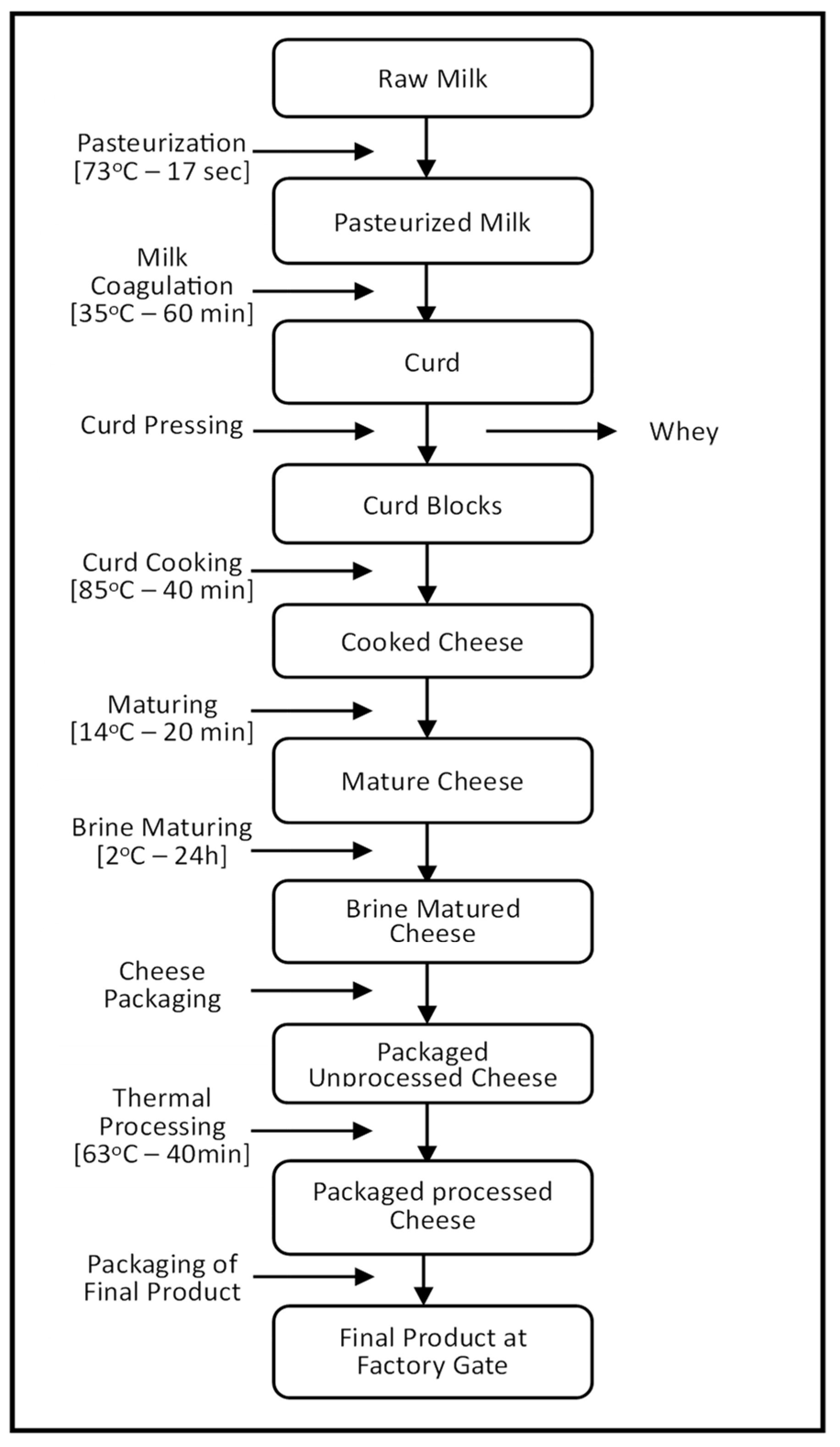
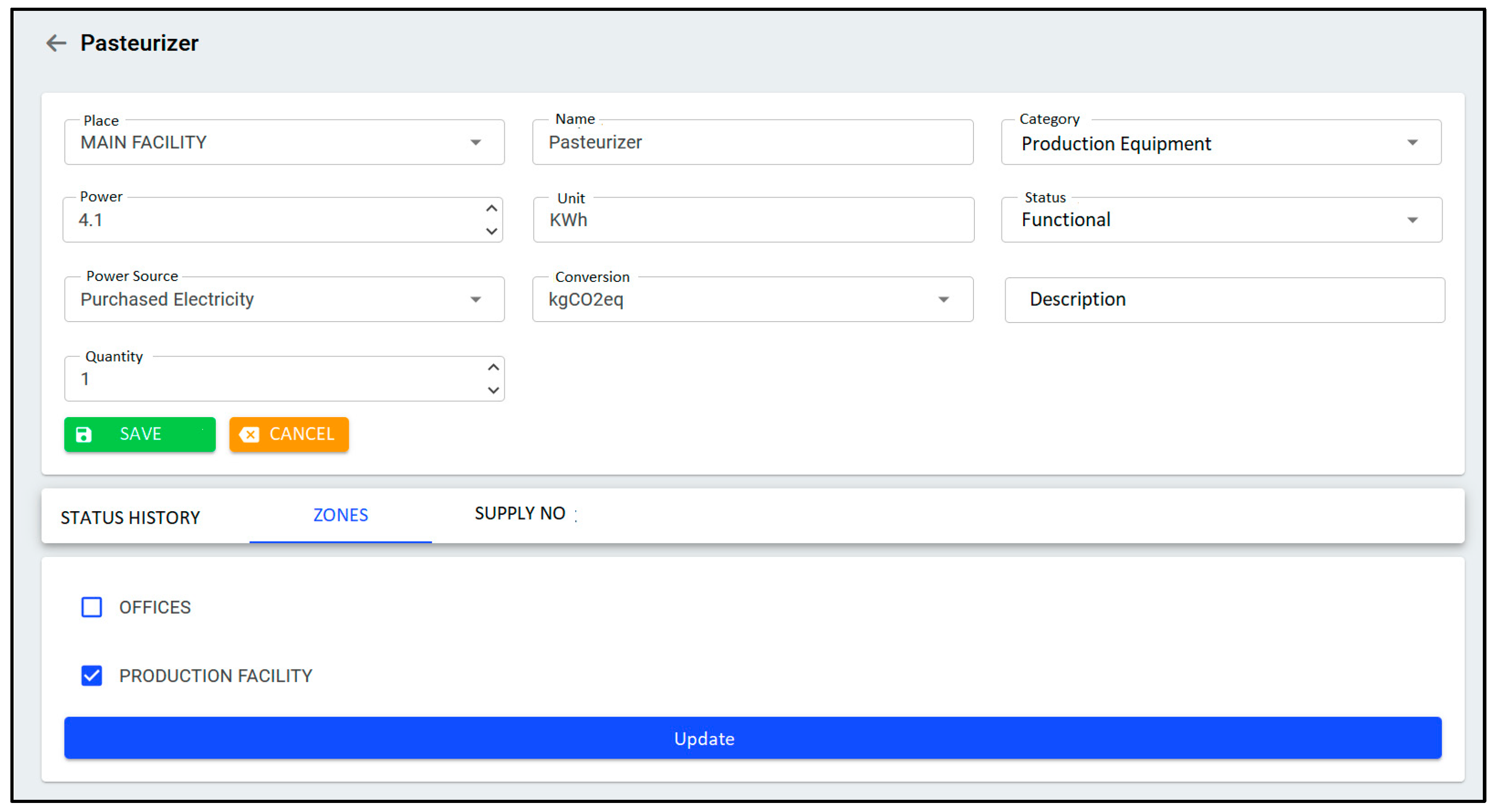


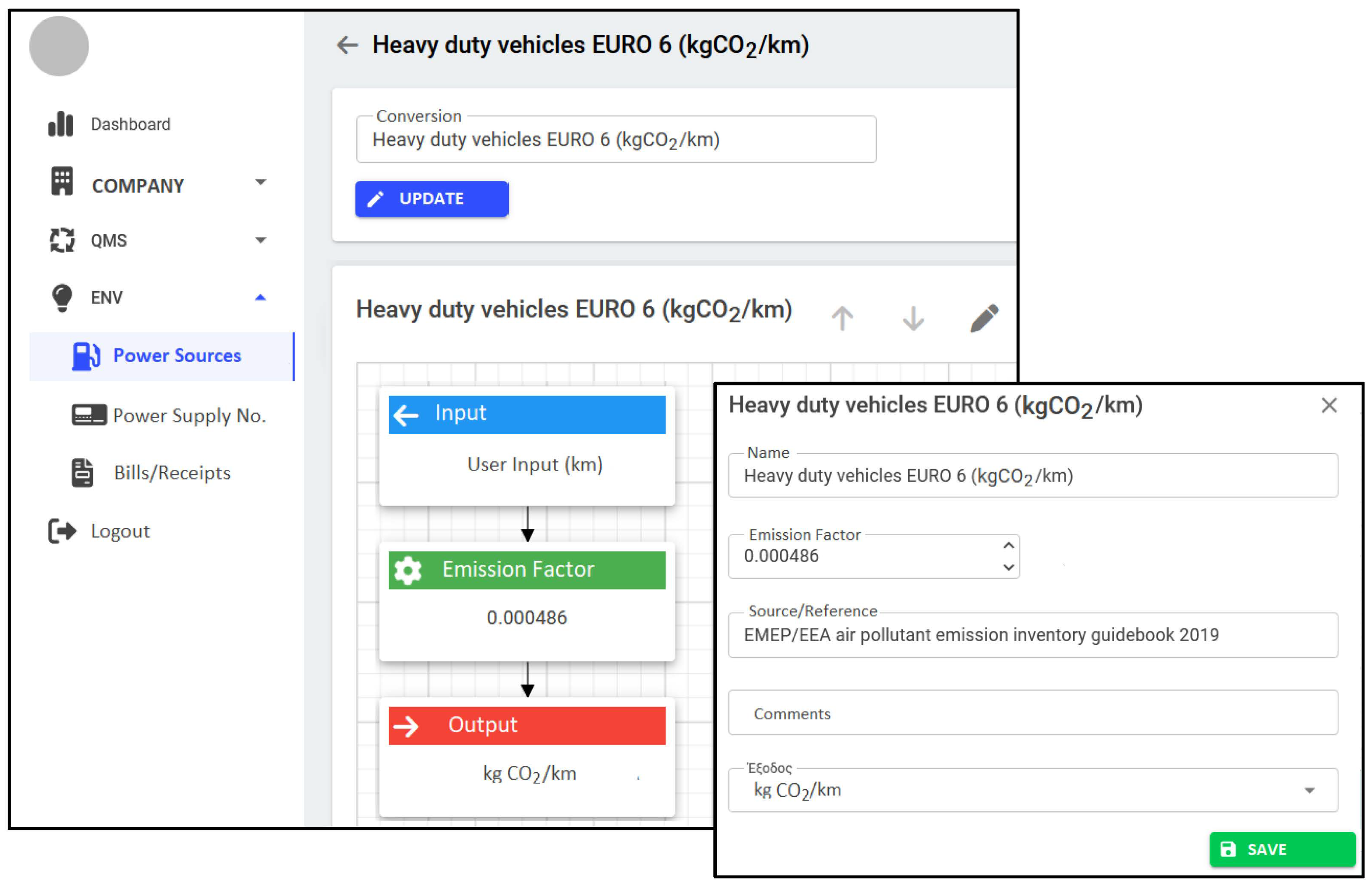
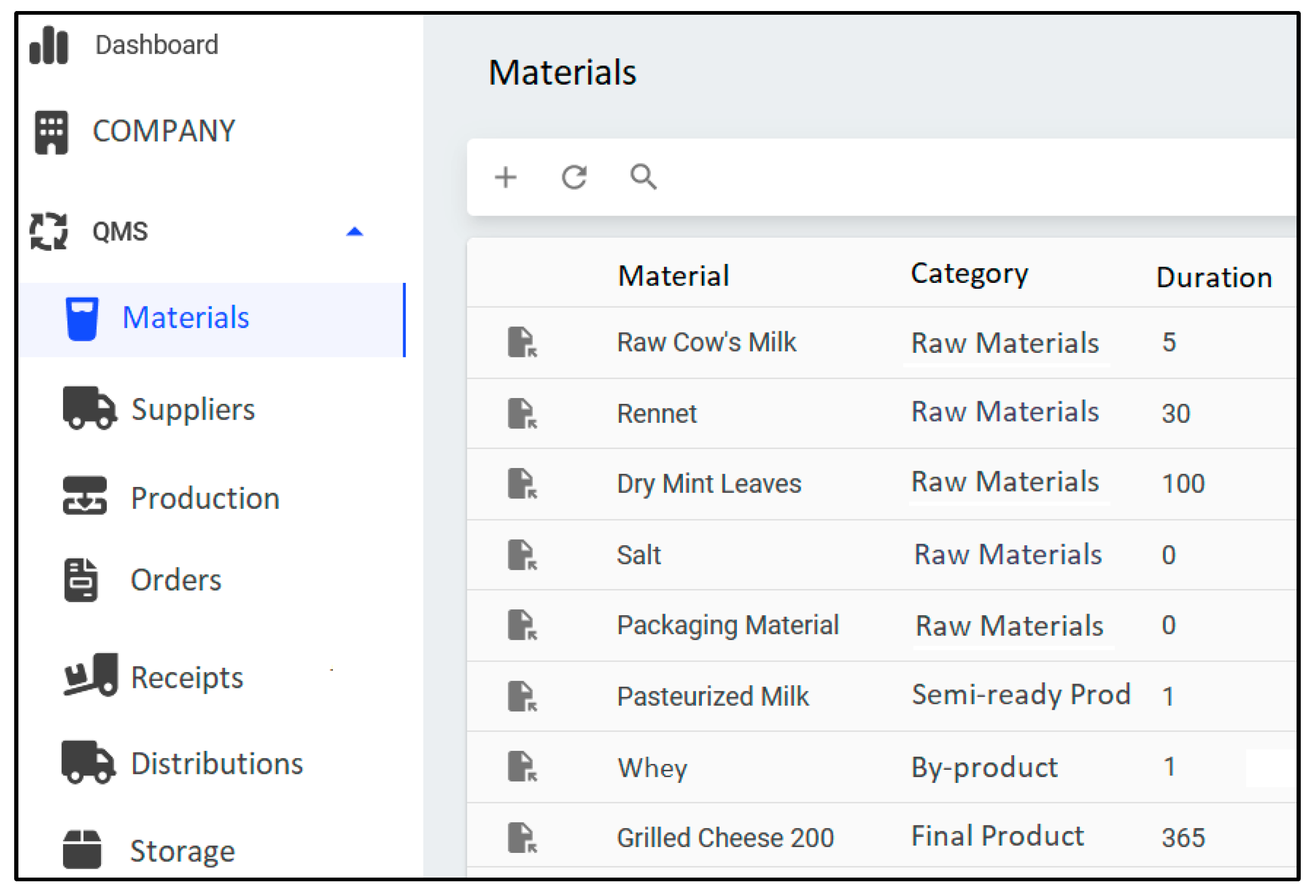
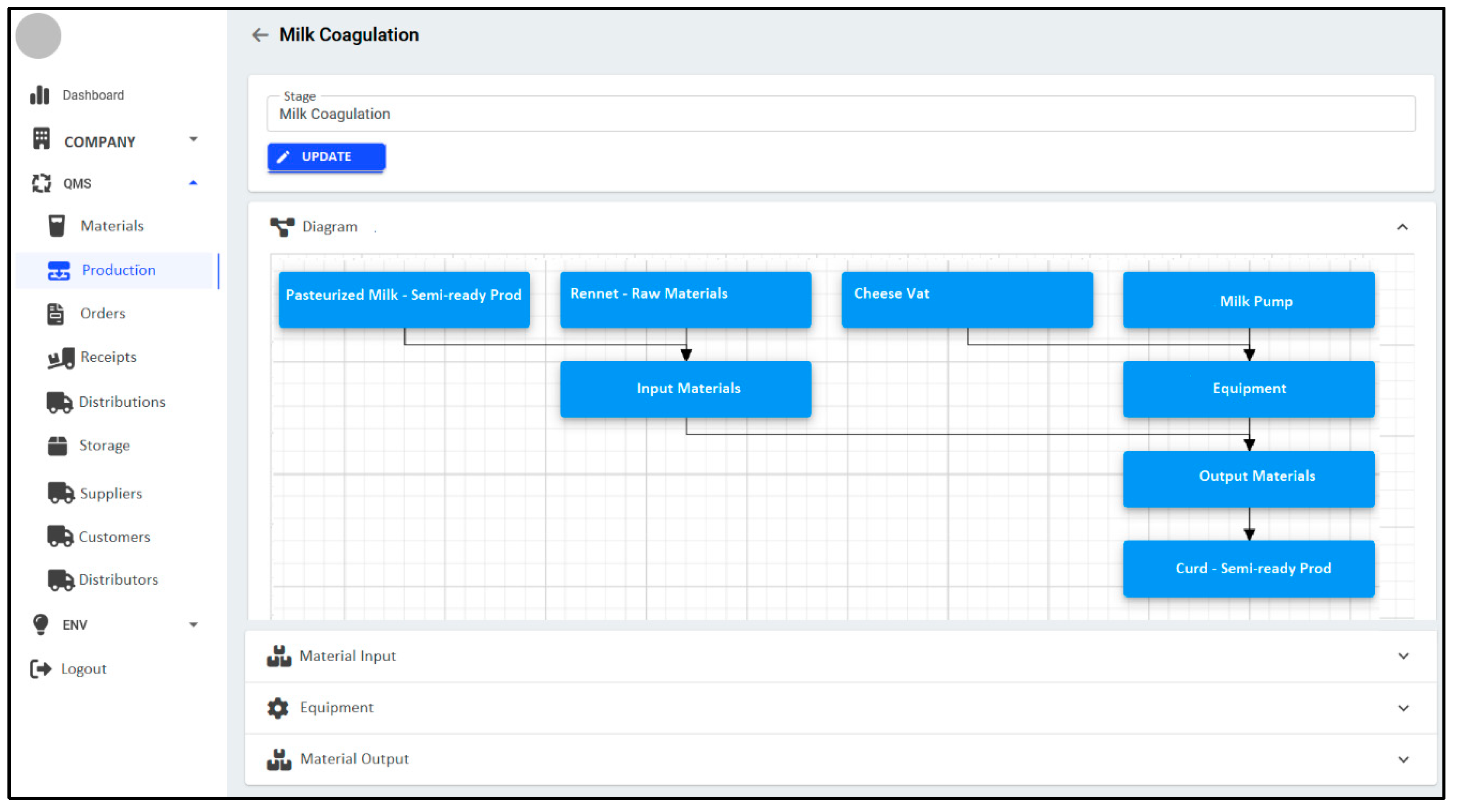
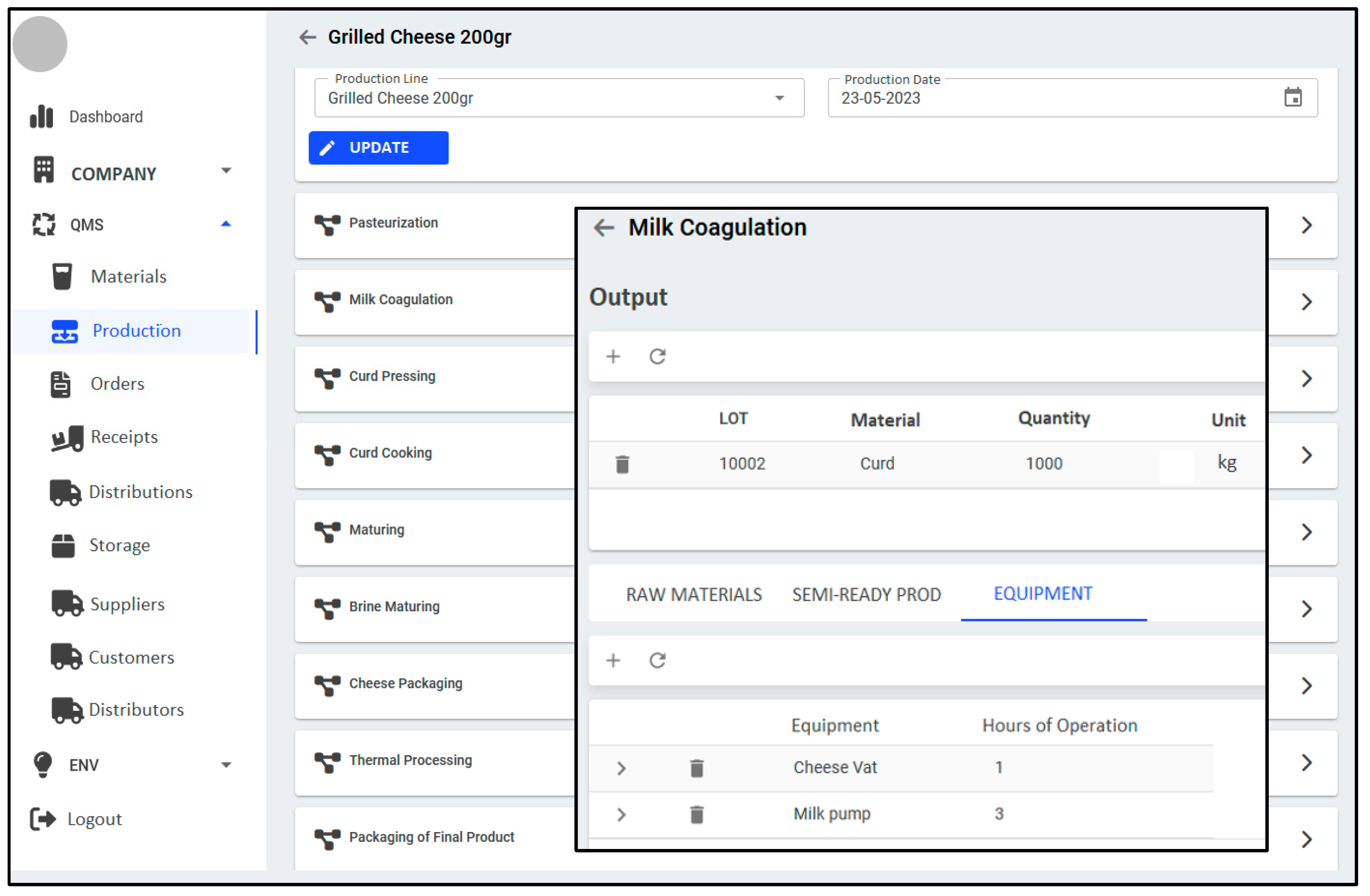
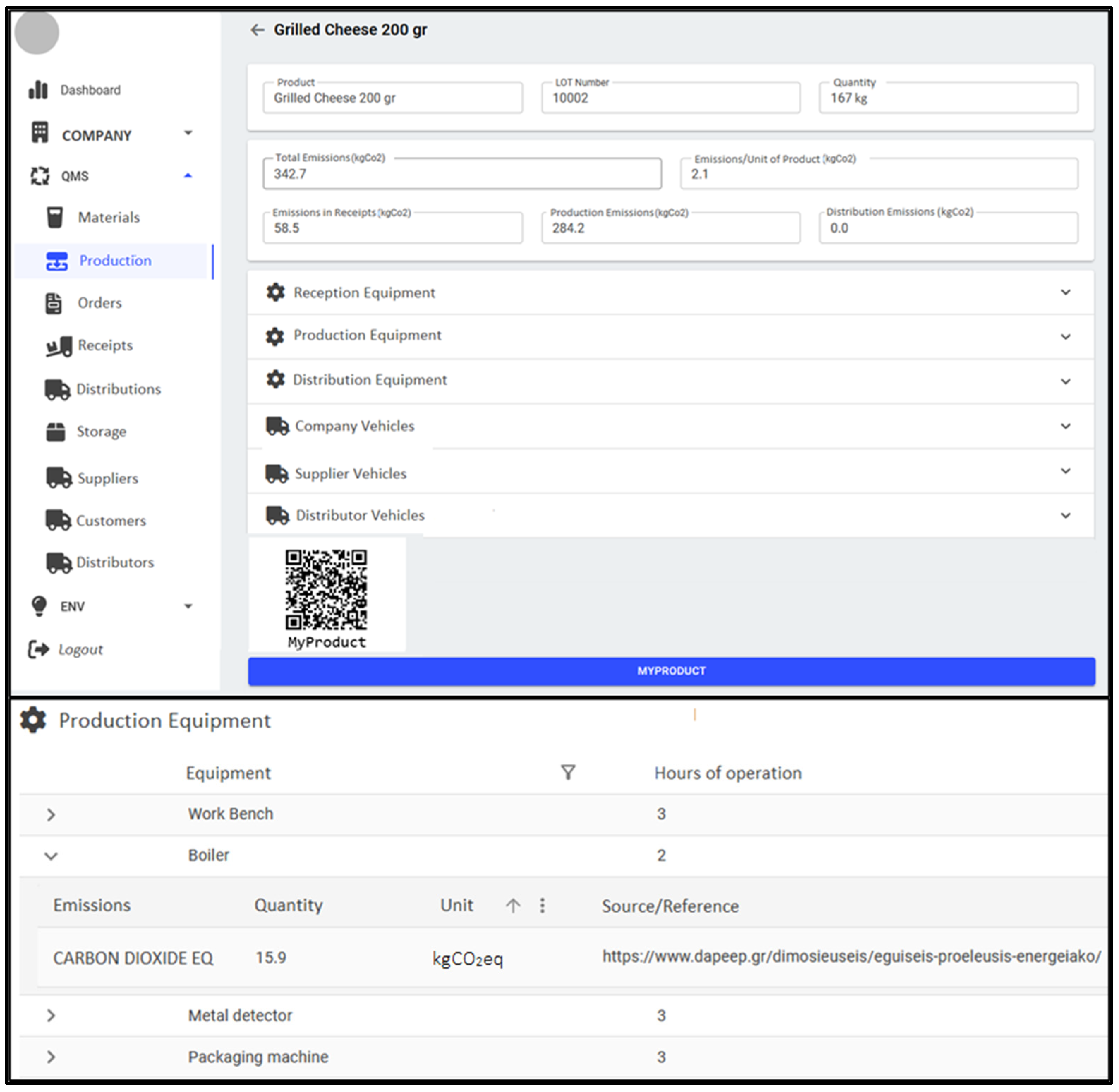
| Category | Barriers—Main Themes | Relevant Research |
|---|---|---|
| Internal | ||
| Economic/ Financial | Large capital requirements Lack of capital/financial resources Unclear financial case/return of investment | [70,83,84,85,86,87,88,89,90,91,92,93,94,95,96,97] |
| Technological | Product design and quality Lack of technology and technical skills | [22,83,84,85,86,89,90,91,92,93,94,95,96,97,98] |
| Organizational | Incompatibility with the current organizational structure Administrative burden Weak management support | [83,85,86,89,90,91,92,93,96] |
| Informational | Insufficient information and knowledge regarding the benefits of CE | [83,85,86,87,88,90,91,92,93,96,98] |
| Cultural | Hesitant company culture Attitude towards sustainability and circularity Risk aversion | [75,83,85,87,90,91,95,96,98] |
| External | ||
| Institutional/ Regulatory | Unclear international policy regarding CE Weak government support | [66,83,84,86,87,90,91,92,93,95,96,97,98] |
| Supply Chain | Finding appropriate suppliers and partners Failure to collaborate with suppliers and partners | [83,85,86,87,90,91,92,93,95,96] |
| Cultural | Consumer awareness “Intention-action gap” [69] | [83,84,86,90,91,92,93,95,96,98] |
| Technology | Definition | Relevant Research |
|---|---|---|
| IoT | A computational system that allows the collection and sharing of products, services, processes, and data in real-time [124,125] | [110,111,112,113,114,115,116,121,122,123,124,125,126,127,128,129,130] |
| Cloud Computing | Technology that allows remote access to business processes facilitates user interaction and information sharing and enables the visualization of all manufacturing resources and processes [125] | [112,114,115,121,124,125,129] |
| AI | Technology that incorporates machine learning capabilities in manufacturing processes [125] | [111,113,115,117,121,122,125,129] |
| Big Data | Technology systems that capture, store, manage, and process high volumes of data [125] | [110,111,112,113,114,115,117,118,121,125,126,129] |
| CPS | Technology that enables automation of industrial operations in real-time [125] | [110,112,113,115,119,120,122,124,125] |
| Blockchain | A system that enables decentralized data storage and sharing of computational resources [131] | [112,115,121,131] |
| AR and VR | Technologies that allow the use of digital tools to access virtual spaces in physical spaces [125] | [112,113,119,123,125] |
| Additive manufacturing | Technology that allows prototyping of parts of products (3D printing) [125] | [110,113,114,123,124,125] |
| 5G | Flexible and low energy consumption technology that allows connectivity between systems that rely on IoT devices [127] | [112,127,128] |
Disclaimer/Publisher’s Note: The statements, opinions and data contained in all publications are solely those of the individual author(s) and contributor(s) and not of MDPI and/or the editor(s). MDPI and/or the editor(s) disclaim responsibility for any injury to people or property resulting from any ideas, methods, instructions or products referred to in the content. |
© 2024 by the authors. Licensee MDPI, Basel, Switzerland. This article is an open access article distributed under the terms and conditions of the Creative Commons Attribution (CC BY) license (https://creativecommons.org/licenses/by/4.0/).
Share and Cite
Eleftheriadis, I.; Anagnostopoulou, E. Developing a Tool for Calculating the Carbon Footprint in SMEs. Sustainability 2024, 16, 1905. https://doi.org/10.3390/su16051905
Eleftheriadis I, Anagnostopoulou E. Developing a Tool for Calculating the Carbon Footprint in SMEs. Sustainability. 2024; 16(5):1905. https://doi.org/10.3390/su16051905
Chicago/Turabian StyleEleftheriadis, Iordanis, and Evgenia Anagnostopoulou. 2024. "Developing a Tool for Calculating the Carbon Footprint in SMEs" Sustainability 16, no. 5: 1905. https://doi.org/10.3390/su16051905





